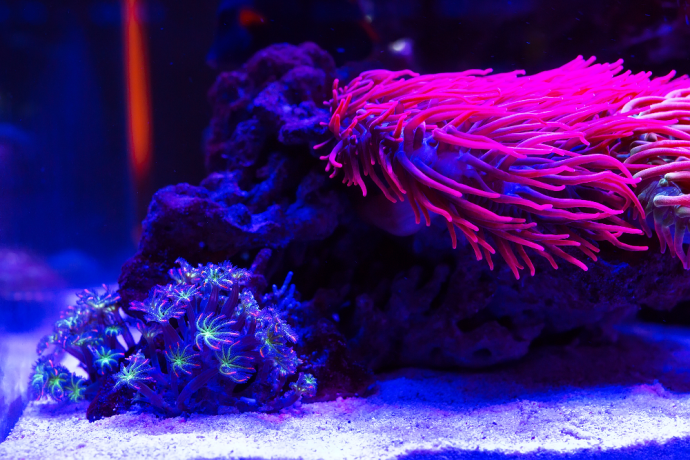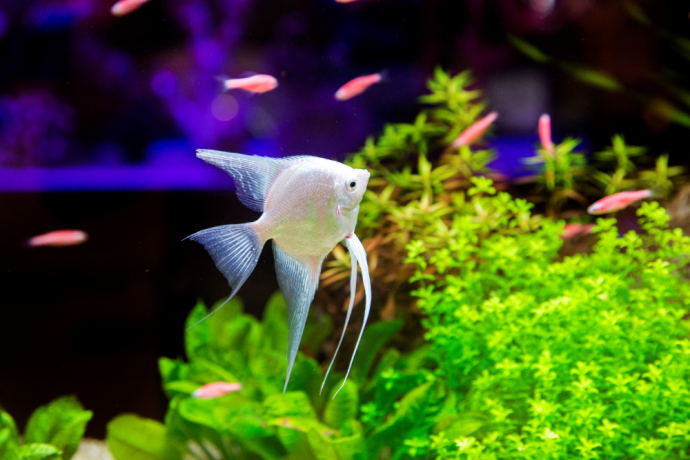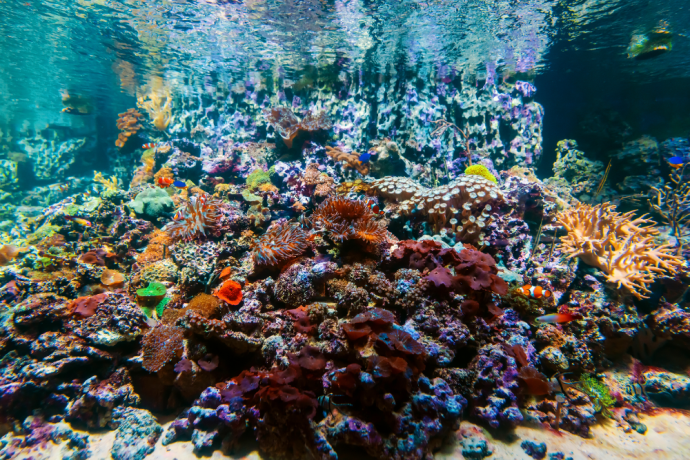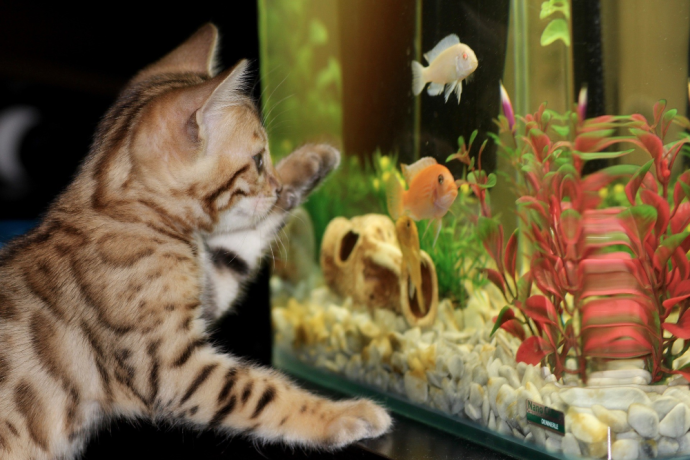How to Set Up a Small Saltwater Tank
Written by:
Author: Alina Andreeva
Alina A. is a professional writer, editor, and pet-lover. She has published over 50 articles on how to care for pets properly. Alina has been writing articles for 3 years, so she has considerable experience in this niche. Her natural curiosity helps her to expand her knowledge and learn new pet care life hacks, which will make your life much easier.
View all 79 articlesLearn about our editorial process and veterinary review board.
Viewed: 496
Updated on: 03/31/2022
A marine aquarium is crystal clear water of a cold bluish tint, bright fancy fish, swimming between rocks covered with pink and purple algae, corals swaying more or less in sync with water. A well-equipped small saltwater aquarium becomes the center of your interior, drawing your guests’ stares. However, the aquarium should not only please the eye but also provide comfortable conditions for its inhabitants.
If the marine aquarium was not such an impressive addition to almost any interior, not many would dare to shell out a ton of money to have a piece of the ocean at their homes. For many people, a small saltwater aquarium is just another piece of furniture. In deciding to purchase it, they think more about how it will look than how to create decent living conditions for its inhabitants. However, a beautiful aquarium is a tank populated by healthy animals that form a balanced community. It is impossible to create a good saltwater tank without first spending enough time on studying new guidelines for marine aquarium design, without learning as much as possible about the biology and habits of potential inhabitants, without trying to understand the ecology of the ocean.
The main difficulty in creating small marine aquariums is that most ocean animals are used to living in an environment with almost constant characteristics. The changes that freshwater fish will not notice are shocking for them. Sea fish cannot tolerate temperature extremes, cannot live in stagnant, oxygen-poor water, and require a strictly defined chemical composition of the habitat. Thus, the life support system of a marine aquarium is complicated, but you cannot do without it.
READ MORE: Why can’t Saltwater Fish Live in Freshwater?
What Is The Smallest Saltwater Aquarium You Can Have?
The smallest aquarium for first-timers should be at least 20 gallons. For experienced fish tank keepers, a 10 or 15-gallon tank will work but is not recommended. In general, underwater creatures love long, wide aquariums [1].
What Do You Need For A Small Saltwater Tank?
1. Live Rocks
First of all, the necessary part of a saltwater aquarium is live rocks, that is, stones used to be part of the ocean reef (sometimes you can even distinguish the structure of old corals in them). The best live rocks are overgrown with sea worms and algae and are inhabited by many small marine inhabitants. If live stones are not available, land rocks can be used instead, provided that they are non-toxic. However, in this case, it is much more challenging to obtain a viable reef, since bacteria and microscopic animals that live on sea rocks take part in natural biological water filtration.
READ MORE: Best LED Light for Reef Tank
2. Sand
Another important component is sand. More often, aquarists buy dry coral sand, and it becomes “live” in an aquarium, but in this case, it is better to add some live sand.
3. Artificial Accessories
Fans of artificial accessories (caves, skulls, sunken ships, painted coral skeletons, etc.) need to remember that saltwater destroys materials much more than freshwater, so the risk of poisoning the system with destruction products, in this case, is very high. Metals are especially dangerous: one coin dropped into a reef can destroy all its inhabitants.
4. Filtration
A strictly necessary element for filtering the reef system is a foam separator or a skimmer. Seawater containing organic substances (mainly proteins) turns into foam, which then flows into a special cup. Everyone who has ever seen a dark brown or black liquid, which the skimmer pumps out of the aquarium, feels deep gratitude to this invention [2].
READ MORE: Aaquarium Canister Filter Reviews
5. Lighting
If you want to keep live corals, you need to take care of the lighting. Putting corals in an aquarium that does not have special reef lighting is like putting indoor plants in a dark closet, since many corals, like plants, use photosynthesis.
5. Heating
Since temperature differences are fatal for almost all marine organisms, there must be an effective thermostat-heater in the aquarium.
6. Pumps
To ensure “ocean” currents, aquarists use special pumps for mixing water. Two-four pumps are located at the opposite ends of the aquarium. They create the necessary flow for corals and marine fish, which carry water between rocks and sand (natural filters), bring corals nutrients, and help fish navigate. A reef cannot live without intense water movement, although no pumps can recreate real ocean currents.
7. Other devices
Also, aquariums use a host of other devices, such as mechanical filters, ozone generator, sterilizers with ultraviolet lamps, equipment for maintaining the required level of calcium, etc.
READ MORE: What You Need for a Saltwater Aquarium
How To Care For A Small Saltwater Tank?
Although it is often recommended to invite a specialist to maintain a saltwater aquarium, it is not so difficult if you prioritize the survival of fish, not just on how your reef looks.
Empty the skimmer cup regularly, check and, if necessary, change the mechanical filters, add fresh water instead of the one that evaporated (the salt does not evaporate, so it does not need to be refilled), add calcium, iodine, and some other substances once every two weeks (or at least once a month), change from 10 to 20% of the water in your aquarium [3]. The latter is necessary, because, despite all the filters, a certain amount of toxins still accumulates in the aquarium, which, if allowed to accumulate without restrictions, can kill all the fish in one unlucky day.
READ MORE: Aquarium Water Changing Guide
Check the quality of water regularly: acidity, ammonium content, nitrites and nitrates, and other parameters. First, you should do it daily, then once every two weeks [4]. Other duties practically do not differ from the maintenance of any aquarium. After gaining experience, this does not take so much time, and with enough enthusiasm, it is more like relaxation than hard work.
READ MORE: Saltwater Fish for Beginners
Can You Have A 5-Gallon Saltwater Tank?
A five-gallon aquarium is really very small for marine fish. Sea fish differ from freshwater species that you may keep in small tanks. Seas and oceans are their natural habitat, and these massive bodies of water are the most stable environments on earth. Salinity and pH do not change. Temperatures stay the same, except for very gradual seasonal fluctuations. Also, marine fish do not tolerate ammonia and nitrite levels, which will often spike even in small-volume seawater tanks [5].
Although a five-gallon marine tank may look good on your desktop, it is not easy to maintain. It is difficult for marine fish to survive in water volumes of less than 20 gallons, so try not to keep them in conditions that are below optimal.
The Bottom Line
Do not fall into the trap of becoming frustrated and disappointed with saltwater tank keeping and giving up, because you were prepared poorly. If you feel the call of the waters and want to have your own slice of aquatic nature, you should know what is expected before starting a saltwater tank, and then dive into the responsibility to follow through with due diligence to care for it. This is especially true for maintaining a small saltwater fish tank.
Useful sourcer for further reading:
- 10 QUESTIONS TO ASK YOURSELF BEFORE GETTING A SALTWATER TANK – Jessie Sanders, DVM, CertAqv, Aquatic Veterinary Services – Mobile fish veterinarian serving California & Nevada
- Management of Salt Water Fish – Carol Curry Iowa State University, Iowa State University Digital Repository
- Routine Health Care of Fish – Ruth Francis-Floyd, DVM, MS, DACZM, Department of Large Animal Clinical Sciences, College of Veterinary Medicine, University of Florida; Barbara D. Petty, DVM, North Florida Aquatic Veterinary Services
- The Private Practitioner’s Guide to Water Quality for Freshwater and Marine Tropical Fish – JoAnna L. Anzelmo, Iowa State University, Dean Riedesel, Iowa State University
- Preventative healthcare in the fish tank – Paul Rose, Animal behavior lecturer at University of Exeter
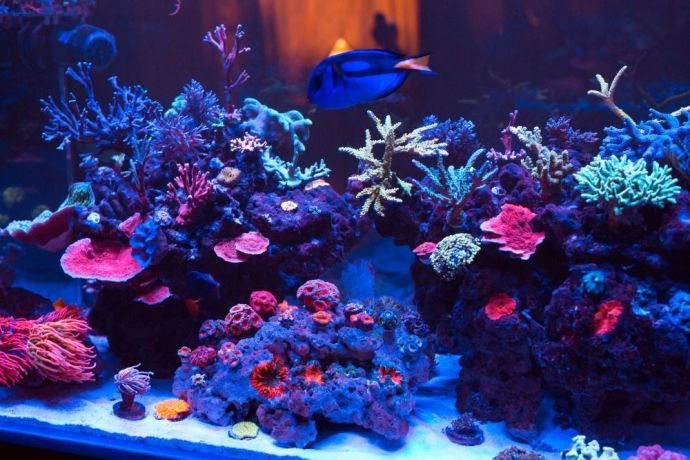 Fish Owners Tips Saltwater Refugiums: How to Make a Refugium for Saltwater Aquarium?
Fish Owners Tips Saltwater Refugiums: How to Make a Refugium for Saltwater Aquarium? - 735
- 0












